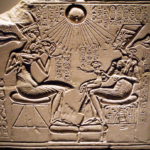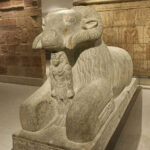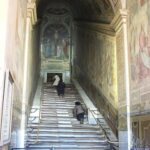“I learned that courage was not the absence of fear, but the triumph over it.
The brave man is not he who does not feel afraid, but he who conquers that fear.”
“The tunnel was damp and dimly lit. The bones of six million Parisians were entombed in this place…I took a few more steps. Then my foot knocked against something. A wooden rattle filled the air, and I froze. As I did, light flared around me. My guide had snapped on his flashlight. Suddenly I wished he hadn’t… Bones were everywhere – scattered across the floor around our feet, cascading from loose stacks against the walls. The glare from the flashlight caught on waves of dust and tendrils of cobwebs that hung from the ceiling… (My guide) thrust the flashlight at me. As I took it, he brushed past me. “What…” I began to call out. Before I could finish my question, the man snapped “Il vous rencontrera ici” (French). And then he was gone, leaving me alone, fifty feet underground, a solitary human being standing in a sea of the dead.”
The above extract comes from the Prologue of the book ‘The Secret Letters of the Monk Who Sold His Ferrari’ written by globally renowned author Robin Sharma. His books have sold over five million copies in some sixty-five countries and seventy-five languages. Most of his books, starting with his inspirational classic ‘The Monk Who Sold His Ferrari’, have been international best sellers.
‘The Secret Letters …’ is a kind of sequel to his masterpiece ‘The Monk Who Sold His Ferrari’. The lead character of this book is a man named Jonathan. Julian (The ‘Monk’) sends Jonathan on a mysterious mission to various locations around the world. At each place, Jonathan would meet specific people from whom he would collect a ‘talisman’ along with a secret letter (a message). The places he visit, the people he meet, and the talismans and the messages he receive are all pre-arranged by Julian with meticulous precision and forethought to help Jonathan learn some of the most critical lessons of life from the exercise.
Jonathan was a person who suffered from claustrophobia – a morbid fear of closed and confined spaces like an elevator. Jonathan could not stand the idea of riding an elevator. Whenever he has to stay in hotel or make a visit, he makes it sure that his room or his place of visit is on one of the lower floors, reachable by taking the stairs. Obviously one of the places Jonathan would visit as part of his global itinerary was the Paris where a cure for his claustrophobia would be found. In Paris Jonathan was to meet someone in one of the most closed, confined and ghoulish places known on this earth – the catacombs. Why so?
In ancient times, Parisians buried their dead on the outskirts of the city, leaving the city free from corpses rotting beneath its surface. But, as the Christian faith spread, that situation changed. Since Christians believed that the dead would be resurrected from their graves at the time of the second coming of Jesus, it became mandatory for them to bury their dead close to their places of worship. Thus, Christians started building cemeteries in the proximity of their churches. Since the churches were constructed nearby human settlements, the cemeteries and the corpses rotting within it started turning an issue directly affecting the lives of people in several ways.
The problems related to decaying dead bodies close to human habitats did not transform into a fatal threat while the population and the number of people dying remained small and there was enough land available for the people to live at a safe distance from the cemeteries. But after the tenth century, the population of Paris started rising rapidly. That created a pressure on the land on the one hand and the need for larger cemeteries to bury the increasing number of people dying on the other. Wars and epidemics added to the problem. Cemeteries started filling up quickly. The Church apparently exploited the situation. Church burials soon became unaffordable except for the few rich. For the rest, another burial ground was found near Paris’s central Les Halles district. This graveyard was named ‘Saints Innocents Cemetery’.
For most of the poor burying their dead in the new cemetery, a coffin was a luxury beyond their means. This led people dumping dead bodies directly into the grave pits. As more and more people died, corpses started piling one over the other. With the pressure on land mounting as population grew population, human settlements started moving closer and closer to the cemetery grounds. By the 17th century, the problem of decaying cadavers reached frightening proportions. The mounds of decomposing corpses started contaminating water and food supplies in and around Paris. The burial grounds became the breeding ground for rats. Hordes of rats carrying contagious diseases started invading homes and public spaces. The decomposing bodies started seeping into the basements of the market at Les Halles. On 30 May 1780, the walls of a restaurant cellar crumbled flooding it with the rotting contents of the Saints Innocents Cemetery. A mason who touched the fallen wall lost his hand to gangrene. The decaying dead bodies in the cemeteries became the scourge of the city. But none had any idea what to do about it.
Eventually, in the late eighteenth century a solution was found. The Police Lieutenant General, Alexandre Lenoir hit up on the idea of using the Paris catacombs as a burial site for the corpses in the Parisian cemeteries. The catacombs were abandoned quarries excavated to provide stone for the construction of the buildings in Paris. Since 1777, the French government had been reinforcing the three thousand kilometres of the city’s underground tunnel network. The catacombs provided the perfect solution to the massive problem of the cemeteries of Paris bursting at its seams with mounds and mounds of polluting corpses. In 1785, the idea became a law. For the next two years, wagons covered by black cloth carrying the remnants of the millions of dead bodies moved from the Parisian cemeteries to the catacombs of Paris.
The remnants (essentially bones) of an estimated six million odd corpses along with the headstones, sculptures and other artefacts were picked up and moved from the overflowing burial grounds around the city of Paris into the maze of the subterranean tunnels. It was impossible to preserve whole skeletons intact. Instead, the bones were sorted by types, stacked, and arranged against the tunnel walls. Visitors (who have the heart to stand the chilling experience) can take a tour of the catacombs where they would be in the nightmarish company of rows and rows of skulls and packs of tibias and piles of spinal disks of unknown legions who had died centuries ago. It would be a dizzying descent down the 130 steps (20 meters) from the street level and a walk of half a kilometre before the visitors would be greeted by the macabre sight of 1.7 kilometres of underground tunnels of some two metre height, lined with skeletons of over six million long dead Parisians stacked to its ceiling.
For someone like Jonathan who suffered from claustrophobia the Paris catacombs are the last place to be in. Yet Julian arranged it so cleverly that Jonathan was taken inside the catacomb by a guide where we found him at the start of this post. Once Jonathan was deep inside the dark tunnel of the dead, his guide simply walked out leaving him alone in the scary company of the piles over piles of bones of the long dead millions. Jonathan was taken into the catacombs to me Antonio. Antonio was an expert working on the restoration of the catacombs. Since Antonio was acting on the basis of Julian’s instructions, he was in no hurry to arrive to save Jonathan from his deadly terrors. Eventually, Antonio arrived. After preliminary pleasantries, Antonio gave Jonathan the talisman and the secret letter as pre-arranged. The talisman was a miniature metal skull with a weird look. The secret message that accompanied the talisman said that one would conquer fears only by embracing it and not by avoiding it. It said that victory lay on the other side of fear. (Darr Ke Aage Jeet Hai?)
That afternoon Jonathan returned to his hotel. His room was on the fourth floor which he, as always, had been accessing by taking the stairs. But on that day, he entered the lobby and headed straight to the elevator. The doors opened. He stepped in and hit the button for the fourth floor. “The doors slowly slid shut. And then the elevator started to lift… I was terrified. But I felt okay”. That was the first time in the last twenty years that Jonathan was inside an elevator. His experience in the Paris catacombs that day taught him that one cannot escape one’s fears by running away from it.
We might think that this great wisdom of embracing fears to overcome it is the discovery of Robin Sharma or the psychological breakthrough of modern science. The truth is that it is simply not so. Much of what we flaunt as the wisdom of modern psychology (or philosophy) was actually well known to pre-historic man. Evidences of pre-historic life brought out by 20th century discoveries suggest that the Palaeolithic people who occupied this earth some thirty thousand or more years ago had been aware of this truth. Those people did not possess the scientific knowledge to send a man to the Moon or undertake a mission to the Mars. But, their understanding of human psychology was no less invasive than that of modern scientific age. The painted caves of the Palaeolithic age was probably used to produce fearless generations just as author Robin Sharma used the Paris catacombs as a setting to get rid of the claustrophobia of the protagonist of his book. The painted cave of Lascaux from France itself is an evidence on it.
In September 1940, four boys – Marcel Ravidat, Jacques Marsal, Georges Agnel and Simon Coencas – set out on an adventure in the Dordogne region of south-western France in the company of their dog Robot. As they trekked through the woods, Robot ran ahead towards a deep depression in the ground. Seeing Robot standing there sniffling, the boys hurried to the spot. They found a sunken hole in the earth hidden under t he overgrowth. The boys suddenly remembered the legends about a subterranean tunnel in the area believed to be leading to another tunnel with huge hidden treasures. They decided to investigate.
he overgrowth. The boys suddenly remembered the legends about a subterranean tunnel in the area believed to be leading to another tunnel with huge hidden treasures. They decided to investigate.
The boys enlarged the opening and slid down through it one by one landing on the dark underground chamber some fifteen meters below. They lit their oil lantern and looked around. Marsal, who was just fourteen years old at that time, described what they saw as a “cavalcade of animals larger than life, painted on the walls and ceiling of the cave; each animal seemed to be moving.”The paintings were brilliantly coloured in red, black, brown and ochre. The boys ventured ahead. As darkness fell and the oil in their lantern dried up, they inched back on their knees and elbows through the steep incline of the narrow shaft to reach the surface.
The young explorers were ecstatic about their discovery. They swore an oath of secrecy about the cave and met again the next morning. This time they used a rope to lower themselves down into the well of the cave. Their oath of secrecy notwithstanding, by the third day, news of the mysterious cave spread like wildfire. Soon the entire village was lining up to have a look at the paintings inside the cave. The boys were frightened and decided to seek the advice of their schoolmaster, Leon Laval.
Mr Laval was a member of the prehistoric society of Montignac. He initially refused to believe the story the boys told thinking that it was a prank they played to take their teacher down the hole. Eventually, Mr Laval agreed to visit the cave. Inside the cave, he was awestruck to see the beauty of the paintings. He immediately knew that the artwork on the cave walls were from a prehistoric period. He instructed the boys to ensure that none touched the paintings. Marsal skipped his school and pitched a tent at the entrance to the cave to secure the cave and its prehistoric artworks. Before long, news spread throughout France, Europe and the world. On the walls and ceilings of the caves were the richest trove of prehistoric drawings and carvings. The cave of Lascaux became known as the Sistine Chapel of prehistoric Art.
The owners of the property on which the cave was located soon began the commercial exploitation of the cave. By 1948, daily tours brought as many as one thousand people a day through Lascaux. Before long, the exposure began to affect the priceless artworks. Carbon dioxide, from the breath of thousands, began to build up in the cave. Condensation formed on the walls and ceilings of the cave produced moisture that ran down the precious paintings. Green growth and calcite formation on the paintings started threatening the safety of the cave. In 1963, France’s Minister of Culture, Andre Malraux, closed the cave to the public. Public can now visit only a painstakingly constructed replica of the Lascaux cave.
The cave art of Lascaux dates back to over 17,000 years. The craftsmanship of those pre-historic artists is amazing. We can speculate endlessly on the meaning behind each of their work. Lascaux is not the only painted pre-historic cave in the world. There are similar caves with awesome artworks all around the world. Some of these caves have artworks dating back to 30,000 years or more. Now, why did those ancient people take the trouble to come down into the deep darkness of these caves with grease lamps and scaffolding to put so much of painstaking effort and skill into painting those walls and ceilings? Why some of the underground labyrinths, like that of Frères at Ari Ariège in the Midi-Pyrénées region of south-western France discovered in 1914, have extremely narrow tunnel openings that a person has to crawl through to get inside? A researcher who visited the place said, “I felt as though I were creeping through a coffin. My heart is pounding and it is difficult to breathe. It is terrible to have the roof so close to one’s head”. What was the use of these caves for the ancient man?
In her book ‘The Case for God’, which is a prodigiously researched attempt to trace the history of man’s faith in the divine starting from the Palaeolithic Age (30,000 BCE) to the present, Karen Armstrong says that some scholars believe that these painted caves were used by the ancient societies to transform boys into men. It was essentially a ritualistic procedure performed as part of their ‘religious’ faith. They literally walked their boys through the shadow of the valley of death to free them from their fears of life and death. Those Palaeolithic age people knew that a fearless generation can be produced only taking them through its worst fears.
Karen Armstrong writes, “…this type of initiation was crucial in ancient religion and is still practiced in traditional societies today. When they reach puberty, boys are taken from their mothers and put through frightening ordeals that transform them into men. The tribe cannot afford the luxury of allowing an adolescent to ‘find himself’, Western style; he has to relinquish the dependency of infancy and assume the burdens of adulthood overnight. To this end, boys are incarcerated into tombs, buried in the earth, informed that they are about to be eaten by a monster, flogged, circumcised and tattooed. If the initiation is properly conducted, a youth will be forced to reach for inner resources that he did not know he possessed. Psychologists tell us that the terror of such an experience causes a regressive disorganization of the personality that, if skilfully handled, can lead to a constructive reorganization of the young man’s powers. He has faced death, came out the other side, and is now psychologically prepared to risk his life for his people…” (Emphasis mine).
The scientific world is often dismissive of the ancient systems of rituals and mythology. But the truth increasingly becoming clear to the modern world is that the pre-historic man, perhaps, knew human psychology at a very deep level to use the tools of religious rituals and mythologies to prepare people for their perilous lives on this earth and for the eventual death they would meet.
Let me now conclude. Man cannot overcome fear by running away from it or by seeking protection against it. Man can get over his fears only by meeting it head on. The primitive man knew it. The psychologist of the scientific world accepts it, although he might credit it to the merits of modern science. But, there is only one problem. More often than not, we often forget this truth in the business of our own lives. We tend to shield our loved ones from all fearsome realities of practical life. We often overlook the unassailable fact that eventually, every human being has to deal with the agonies of life and the terrors of death alone. This being so, our overenthusiasm to protect would only harm and not help those we seek to guard.
————————












